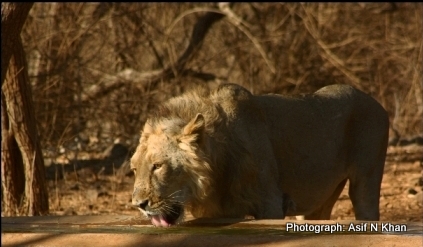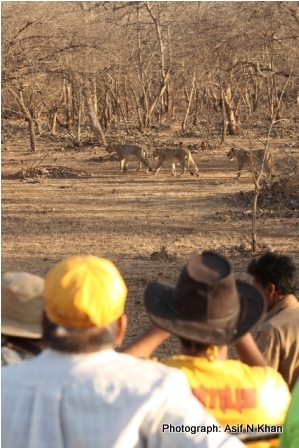Re-Introduction Of Lions By Human Intervention
By Marianne de Nazareth
24 April, 2013
Countercurrents.org
 Often times while watching a National Geographic film on the translocation of Crocodiles which have strayed out of their habitat, or reading about elephants being chased back into the forest with crackers, one wonders if the animals will finally return and if the expensive translocation will really work. However the translocation of species to areas where they have died out so they regenrate a fresh new population is an idea worth exploring says Bombay Natural History Society (BHNS).
Often times while watching a National Geographic film on the translocation of Crocodiles which have strayed out of their habitat, or reading about elephants being chased back into the forest with crackers, one wonders if the animals will finally return and if the expensive translocation will really work. However the translocation of species to areas where they have died out so they regenrate a fresh new population is an idea worth exploring says Bombay Natural History Society (BHNS).
According to the Bombay Natural History Society, the Supreme Court of India’s recent judgment permitting translocation of some of the endangered Asiatic Lions from Gujarat’s Gir National Park to Kuno Palpur Wildlife Sanctuary in Madhya Pradesh is considered to be a good and an essential step for the long-term survival of the species. They term this type of re-introduction as “Human Assisted Dispersal”, which means re-introduction of a species to some part of its former range through human intervention. BNHS is of the opinion that many other threatened species can be conserved using this approach wherever it is necessary and appropriate to do so.
Rationale
 The re-introduction of Asiatic Lions in some part of their former range, which once existed from West Asia to eastern parts of India, has long been debated at various levels. Commenting on the re-introduction of Asiatic Lions in Kuno Palpur Wildlife Sanctuary, Dr Asad Rahmani, Director, BNHS said ”It is a very good development and we welcome the move. Relocating some lions is a wonderful idea for the long-term survival of the species and should have been done much earlier”.
The re-introduction of Asiatic Lions in some part of their former range, which once existed from West Asia to eastern parts of India, has long been debated at various levels. Commenting on the re-introduction of Asiatic Lions in Kuno Palpur Wildlife Sanctuary, Dr Asad Rahmani, Director, BNHS said ”It is a very good development and we welcome the move. Relocating some lions is a wonderful idea for the long-term survival of the species and should have been done much earlier”.
Explaining the rationale, he added that the region where the re-introduction would take place was formerly a part of the natural range of Asiatic Lions. Lions are adaptable animals and can withstand high temperatures that are observed in central India. They were also found in a wide range of habitats and climatic conditions in their former range across Asia. Dr Rahmani who is also a member of the National Board for Wildlife (NBWL) has been quoted in the recent judgment saying that that sporadic presence of tigers in Kuno was in no case detrimental to re-introduction of lions.
Human Assisted Dispersal
BNHS observes that whenever natural dispersal of wild species is not possible any longer due to lack of habitat corridors because of human activities and settlements, it is essential to have Human Assisted Dispersal. Dr Rahmani elaborates on the point saying that although there has been good growth in the numbers of Asiatic Lions in Gujarat following conservation measures, there are no forest corridors available at present for the animals to disperse to other areas of their former range in other states. In such cases Human Assisted Dispersal is required. The same can be used for other threatened species on case to case basis.
African experience
Not just in their former range in Asia, lions have been adaptable animals in Africa too. Dr Rahmani observes that in sub-Saharan Africa, lions are today found in a variety of habitats and climatic conditions ranging from the humid tracts around Uganda to the desert regions of Kalahari in Botswana and the Namib Desert in Namibia.
The iconic Lion is a species we need to preserve and encourage a growth in their population. Human assisted dispersal in areas, where lions once roamed and are lost maybe due to human animal conflict, there is hope once more of rejuvenation of the species.
(The writer is an environment and science journalist, adjunct faculty St. Joseph’s PG Media College and PhD scholar Madurai Kamaraj University)
Picture credits: Asif Khan
Comments are moderated


